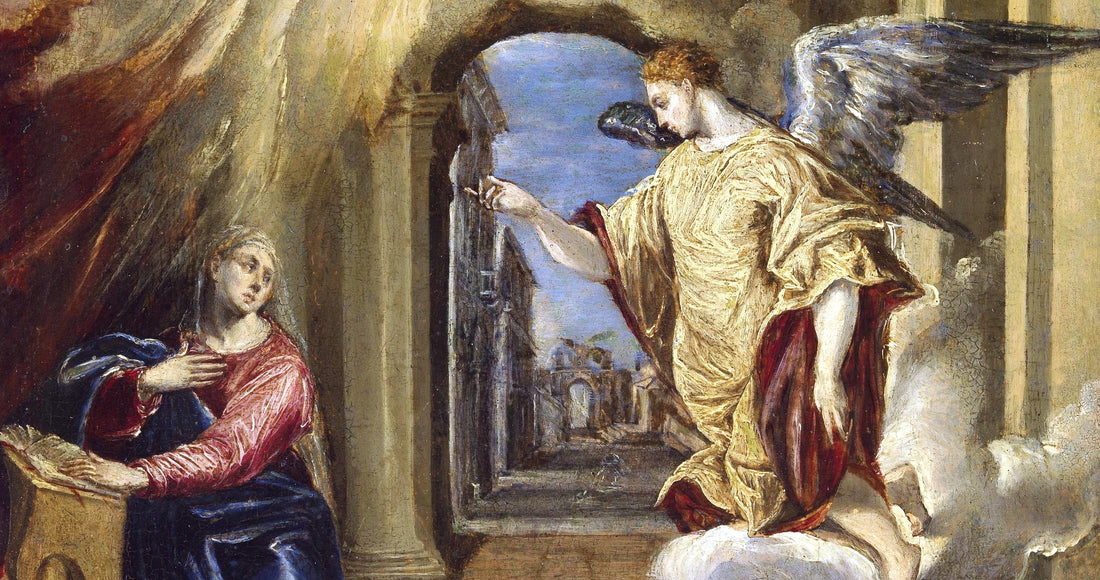
Mary’s May Crowning: Part 1 - The Annunciation
Dr. Andrew SwaffordThis is the first part of a series that will follow the biblical story of Mary throughout May. To honor her during her month, we are diving deeper into the mysteries of the Rosary where Mary was mentioned in the Scripture passage—thereby reflecting on the Blessed Mother’s role through the Gospels.
The first mystery we will reflect upon is the Annunciation from St. Gabriel, the archangel.
For more on Mary’s spirituality, pre-order Ascension’s book, How to Pray Like Mary
The Annunciation
Mary stands here at the turn of salvation history, embodying the faithful of Israel and making way for the Messiah. In fact, the angel’s greeting “Hail” (χαῖρε) is the exact same as that given to Daughter Zion in the Greek version of Zephaniah 3:14. This is significant because “Daughter Zion” in the prophets generally refers to the eschatological people of God—that is, the people of God as God has called them to be; Mary, then, embodies this glorious radiance which God has always destined for his people. And the Zephaniah passage continues: “The King is in her midst” (Zephaniah 3:15); indeed, in the Annunciation the King is in her midst, in the womb of the Blessed Virgin (see Joseph Cardinal Ratzinger’s book, Daughter Zion, pages 42-3).
Moreover, the angel doesn’t address Mary by name, but rather astonishingly as:
“Hail, full of grace.”
This breathtaking greeting offers a glimpse of the grandeur of the Incarnation, as seen from heaven’s vantage point.
Further, the phrase “the Lord is with you,” used by the angel with reference to Mary, occurs throughout the Bible in order to indicate God’s presence and support for accomplishing his mission, as for example with Moses (Exodus 3:12), Joshua (Joshua 1:5, 9), Gideon (Judges 6:12), and Jeremiah (Jeremiah 1:8). This means that Mary, too, stands on the cusp of some great moment in salvation history. And Mary responds with unflinching faith:
“Behold, I am the handmaid of the Lord; let it be to me according to your word.”
(Luke 1:38)
In a sense, God’s plan hinges on the faith and obedience of the Virgin Mary; and for that, all generations call her “blessed” (Luke 1:42).
Sometimes much is made of the distinction between Jesus’ physical family and his spiritual family—the latter marked by those who “hear the word of God and do it” (Luke 8:21; 11:27-28). But a distinction need not entail a separation; and in fact, St. Luke portrays Mary as the one who quintessentially “hears the word of God and does it” (see Luke 1:38-39; 2:19, 51); in other words, she goes before us as model disciple and embodiment of the Church; and in Luke’s sequel (Acts of the Apostles), she is there persevering to the end with the disciples (Acts 1:14).
May we follow Mary’s path of saying “yes” to the Lord from beginning to end:
“For with God nothing will be impossible.”
(Luke 1:37)
For Luke’s narrative of the Annunciation, read Luke 1:26:38.
Discussion
In what way have you said yes to God lately as Mary did at the Annunciation, allowing his grace to flow into your life?
You May Also Like:
Mary: Mother of God (video)
The Annunciation: ‘Greatest Event in Our History’
Mary: A Biblical Walk with the Blessed Mother (study program)
About Andrew Swafford
Dr. Andrew Swafford is associate professor of theology at Benedictine College. He is general editor and contributor to The Great Adventure Catholic Bible, published by Ascension. Swafford is author of Nature and Grace, John Paul II to Aristotle and Back Again, and Spiritual Survival in the Modern World. He holds a doctorate in Sacred Theology from the University of St. Mary of the Lake and a master’s degree in Old Testament & Semitic Languages from Trinity Evangelical Divinity School. He is a member of the Society of Biblical Literature, Academy of Catholic Theology, and a senior fellow at the St. Paul Center for Biblical Theology. He lives with his wife Sarah and their four children in Atchison, Kansas.
Keep an eye out for his latest project with Ascension, a new Romans study which will arrive in the summer of 2019.
Featured painting, The Annunciation, by El Greco (1541-1614), sourced from Wikimedia Commons.